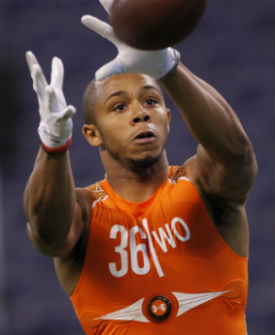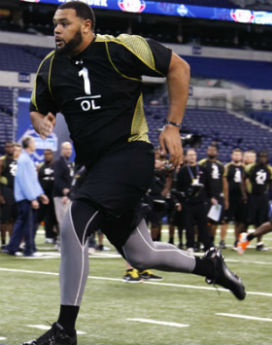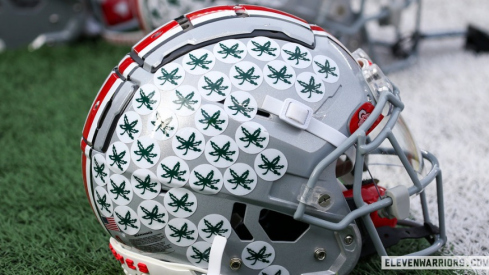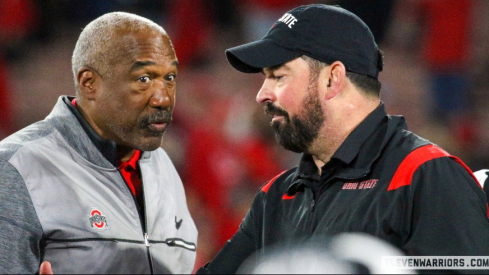 Posey looking for a starting role.
Posey looking for a starting role.Good afternoon, ladies and gentlemen and welcome to your first stat session. It's kind of like a skull session, but with more numbers and posted a bit later in the day. This week I took a look at the prospects for our recent NFL-bound Buckeyes - is it possible to predict how well a player will do in the NFL based upon their combine performance?
I take a look at Joe Landers' "Relevance of the Combine"1 for my data, in which he devises two new measures for combine performance - the "exceeded peer average" or EPA, and the "attribute success correlation" or ASC. Landers describes the two measures best: “The EPA study gives us the correlation between overall physical attribute testing performance and on-field success. It takes all seven physical attribute tests into account and tells us in how many categories a certain prospect performed better than his peers...EPA is a better indicator of future success than any particular attribute test." The ASC “aims to draw correlations (or dispel myths) between specific physical attribute tests and NFL success.” He then looks at what string the player spent most of their time at during the 2008 season. It's an imperfect measure of success in the NFL, but adequate for our purposes.
One thing I will concede - this analysis is from 2009, using data from 2005-2008 rather than the most recent classes’ data. I’m ok with this though - there shouldn't theoretically be a huge difference in talent between the 2008-2012 classes. Another potential problem with predicting NFL success is that so much is context dependent. If you're a wide receiver, can your quarterback actually get you the ball? Is the roster already loaded with superstars at your position?
Some academic studies have criticized the combine as a predictor of football abilities. Not to mention the fact that intangible factors, like dedication, work ethic, luck, or your proclivity for the reefer can heavily impact both your draft position and your chances of starting and succeeding. These are certainly important to the discussion, but it's nonetheless useful to see how physically prepared our Buckeyes were for the combine and their likelihood of starting in the NFL based on that alone. Not to mention the fact that we'll hopefully see big combine improvements with Mariotti.
Unfortunately there is only official combine data for Adams, Herron, Brewster, and Posey - Ebner, Sweat and Shugarts weren't invited to the combine.
| Year | Name | Height | Weight | 3Cone | 40 | Bench | Vert | Broad | Shuttle |
|
2012 |
Adams | 79 | 323 | 7.94 | 5.4 | 19 | 28 | 100 | 4.95 |
| 2012 | Brewster | 74 | 312 | 7.73 | 5.35 | 29 | 25 | 96 | 4.6 |
| 2012 | Boom | 70 | 213 | 6.97 | 4.66 | 22 | 35 | 117 | 4.04 |
| 2012 | Posey | 74 | 211 | 7.03 | 4.5 | 14 | 36 | 123 | 4.15 |
Mike Adams
Maybe it was a bad day at the combine for Mike, but he came out with an EPA of zero on the day when the optimal EPA for OTs is 5. While this certainly isn’t a sign for optimism, the good news is that only one combine test - the 40 yard dash - is strongly correlated with NFL success. While he probably lost a fairly significant amount of money and draft position for his reefer madness, teams were likely also turned off by his relative physical performance.
Around the combine day, most analysts were specifically concerned with his poor bench performance. His supporters argued that it is simply harder for guys his height to bench anyway - long arms means farther to lift. The ASC and EPA results suggest that teams should not fear over his bench performance as the bench press is “just a piece” of OT success in the NFL.
Besides, Mike Adams’ hype, even from when he was anointed the “next Orlando Pace” as a 5-star recruit out of high school, was never about his physical performance as much as it was his size. The guy comes in at 6’7” and 323 pounds - an ideal size for a LT. OTs that score below 5 EPAs “all kind of blend together,” so Adams might be able to get away with sub-par relative performances if he puts in the necessary work and dedication.
Boom Herron
For running backs, the optimal EPA is 4, but Landers suggests that we should be just as impressed with 3, 4, 5, and 6 EPAs as one that is above the average in all attributes. As we might imagine, the most important combine test is the 40, with “two-thirds of RB prospects (11/16) that EPA’d in the 40 started in 2008.” However, Landers notes that “it’s not crucial that a RB runs a 4.24 like Chris Johnson.”
Boom actually came away with a great combine, with 5 EPAs in shuttle, broad jump, three cone, vertical, and bench. He did get some negative press from his relatively slow 40 time (the most important predictor), though reports suggest he improved his time during the pro day. If I am an NFL GM, I’m happy Boom meets the physical requirements in the draft, but I’m even more impressed with his leadership abilities, tenacity, and devotion to the team. Boom wasn’t always the most flashy back, but he’s definitely the kind of guy I see having a productive NFL career.
Devier Posey
 Can he overcome his relatively poor combine showing?
Can he overcome his relatively poor combine showing?Posey actually has an excellent chance to start in the NFL purely based upon his physical performance: he scores 5 EPAs, including the two most important attributes - the 40 and the vertical leap.2 83% of WRs who EPAd in the 40 and the vertical started in the NFL.
Michael Brewster
I was personally extremely disappointed with Brewster not being drafted, as he was always a leader from the moment he committed to the university. The Jaguars really got a steal here by getting Brewster as a free agent, as not only does he seem to have intangible leadership qualities, but he’s also right in the sweet spot in terms of statistically relevant combine numbers.
Brewster ended with 3 EPAs in 3-cone, bench, and short shuttle. Landers notes that “89% of Center prospects who EPA’d in the Short Shuttle started in 2008,” which certainly bodes well for Brewster. Not to mention that he had fairly solid bench numbers - 29 reps compared to the average of 25.6. Two thirds of all starting centers managed to do at least 26 reps using Landers’ data. Somewhat surprisingly, center is the third most predictable position on offense, which bodes well considering his numbers. Look for the leader of the Brew Crew to fight hard for a position this season.
- In particular, read the "EPA and ASC Cheat Sheet" section. Super useful.
- Ok, Posey technically misses the EPA for the vertical by .05. I’m inclined to give it to him - aren’t you?

